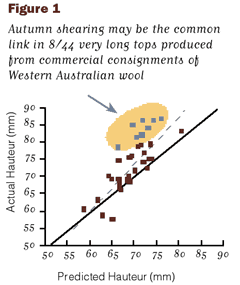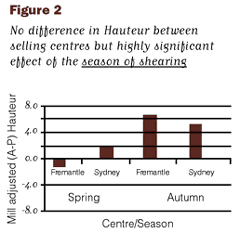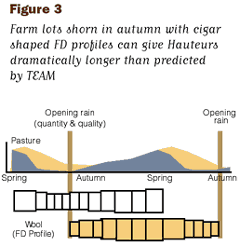
Processing performance is predictable from the raw wool characteristics using the so-called TEAM (Trials Evaluating Additional Measurement) equations, but there is a widespread perception that wools from Mediterranean environments do not process as well as similar wools from less-seasonal environments. In contrast, there is some evidence that the TEAM equation poorly predicts the performance of Mediterranean wools. Figure 1, for instance, shows the relationship between Hauteur (fibre length in the top) predicted from the TEAM equation and actual Hauteur. Note particularly the eight outlying points highlighted in the Figure—these eight consignments produced tops with very large Hauteur (greater that 80mm). Dr Chris Oldham of the Wool CRC noted that these outliers were all from autumn-shorn consignments. This lead him to propose that autumn-shorn fleeces produce longer actual Hauteur than those from spring-shorn fleeces with the same fibre diameter and predicted Hauteur. He further suggested that this season of shearing effect on the predictive ability of the TEAM equations would be greater in more seasonal environments.

To test these hypotheses, Dr Oldham and his colleagues, Dr Bob Couchman of Woolmark Company and Dr Gary Robinson of CSIRO Textile and Fibre Technology, compared the processing performance of batches of wool from Fremantle and Sydney selling centres. The batches were matched for fibre diameter, vegetable matter, staple strength and TEAM-predicted Hauteur.
The results are shown in Figure 2. There was no difference in Hauteur between selling centres, but there was a highly significant effect of season of shearing and an interaction between selling centre and season of shearing. In other words, autumn-shorn wools processed to longer Hauteur than predicted from the TEAM equation, and this effect was greater in wools sourced from a Mediterranean environment than those from a less seasonal environment.

Dr Oldham said it is tempting to conclude that the effect of season of shearing is related to the staple profile (see Figure 3).

“It may be”, said Dr Oldham, “that we need to develop a fast and cheap method of measuring staple profile if it predicts processing performance better.” He also suggests that more work is required to determine:
What is the characteristic responsible for the processing difference?
Is the response repeatable for a range of diameters, vegetable matter levels and predicted Hauteur?
The bottom line … Autumn-shorn wools from highly seasonal environments appear to process better than one might expect from their raw wool characteristics. They may therefore be unfairly discriminated against at present.
In this issue of The Wool Press: